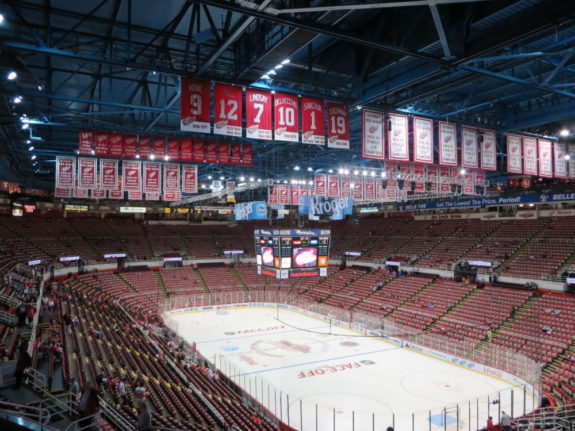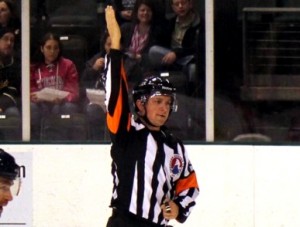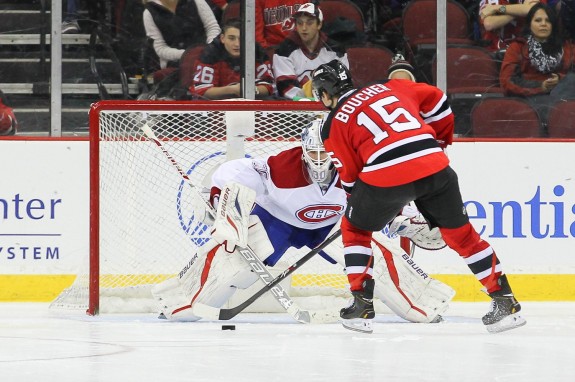Originally published in 2014.
This is part of our Beginner’s Guide to Hockey, the full series of posts can be found here…
Tonight is the night of your first NHL game. Imagine yourself walking into a sparkling arena. Chilly air nips at you as you walk the concourse. Clean tiles and bright lights line the outer part of the arena. And you have yet to even make it your seats. As you walk into the stadium and out of the concourse, the brilliant lights shining on the ice reveal a gleaming surface of perfection. The gigantic scoreboard hanging over the center flashes highlights of the home team. The climb up the stairs to your seats seems daunting, but even if you’re in the back row, the view is incredible. Welcome to hockey, quick, learn the basics before the action starts.
The Anatomy of a Hockey Game
Who Are These Guys in Sweaters?
Well, the dark sweaters are the home team. If you were watching at the arena shown above, Joe Louis Arena the home of the Detroit Red Wings, the dark sweaters would be mostly red. The home team always wears their darker sweaters that feature their main color. The visiting team will wear their white sweaters. A home team can choose their alternative third jersey, which will be a different color altogether. When the team in the dark colors scores a goal, be prepared for pandemonium. A horn will sound, the crowd will go wild, and a red light behind the visiting goalie will shine bright.
“How would you like a job where when you made a mistake, a big red light goes on and 18,000 people boo?”
–Jacques Plante
What About the Striped Sweaters?
Those are the referees. Feel free to boo them if they make a lousy call. Why? Because they’re the refs and no-one ever cheers for them. The guys with the orange bands around their arms are the referees. They are the ones that call the penalties (more on them later) and goals or no goals. There are two of them. The two other guys, without orange bands, are linesmen. They are subordinate to the referees but have their own responsibilities. The linesmen drop the puck for face-offs and call icing and offisdes. Because of this, they spend most of their time on the blue lines or goal lines and stick as close to the boards as possible.
What the Heck is Going On?
So, the puck has dropped and all of a sudden ten skaters are moving all around the ice at high speeds. Six players are on the ice from each team. One of these is the goalie and he spends all his time in front of his own net. The skaters are trying to get the tiny black puck past that big goalie and into the net. They will play three periods of twenty minutes. The clock will stop when the puck is not in play. That means if the puck is frozen, sent out of play, or someone scores a goal the clock will stop. No running clocks like soccer here. So, whenever you hear a referee blow his whistle, that clock will stop.
How Does it End?
Every game will go at least the full sixty minutes. This is called regulation. At the end of regulation, the team with more goals wins. If the teams are tied, the game will continue into overtime. Overtime is a five minute extra period where only three skaters and a goalie take the ice at a time. This fosters more open ice and faster play. Overtime is sudden death. That means, the next goal scored wins the game immediately.
If after those five minutes, nobody has scored, a shootout will take place. A shootout is a series of penalty shots (one-on-one skater against goalie). It starts as a best of three as teams take turns shooting at the opponent’s goalie. The team with the most goals after the best of three wins.
If, again, it is not settled, it will go on one by one until a winner is crowned. If the first to shoot scores and his goalie stops the next shot, that team wins. If the first to shoot fails to score and his goalie is scored on next, the second team wins.
In the playoffs, there is no shootout. There is overtime again, but the teams play five-on-five and each overtime period is twenty minutes. However, the sudden death rule still applies.
Related: Full Hockey 101 Series



